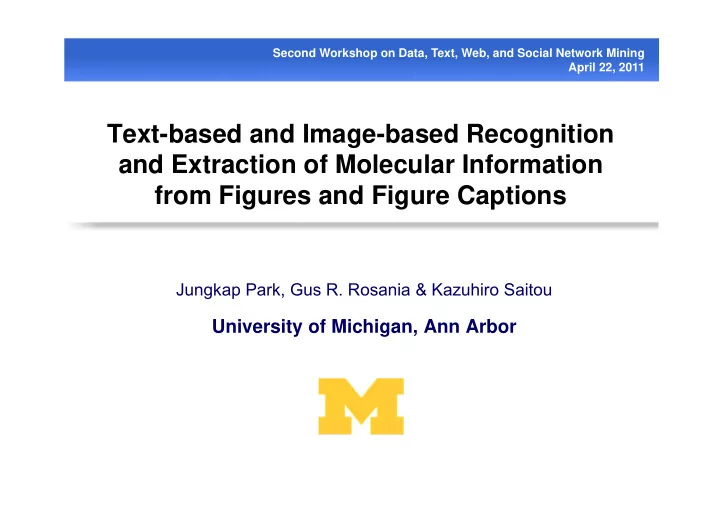

Second Workshop on Data, Text, Web, and Social Network Mining April 22, 2011 Text-based and Image-based Recognition and Extraction of Molecular Information from Figures and Figure Captions Jungkap Park, Gus R. Rosania & Kazuhiro Saitou University of Michigan, Ann Arbor
Outline Overview of Image-based Annotation ChemReader Annotation Strategy and Test Result Chemical Literature Database Preliminary Statistics Future Works
Why ChemReader? Scientific literature Chemical Database PubChem PubChem Journals Journals ChemBank ChemBank Patents Patents ChemDB ChemDB Books Books ChemMine ChemMine Papers Papers DrugBank DrugBank Project reports Project reports ChemReader GLIDA GLIDA Websites Websites QueryChem QueryChem Theses Theses … …
Searching for chemical information The problems: • Too many synonyms • Often referenced by chemical structure diagrams Ex) Aspirin • Acetylsalicylic acid (ASA) • 2-acetyloxybenzoic acid • acetylsalicylate P Vishweshwar et al, J. Am. Chem. 2005 • Acylpyrin • Colfarit • Ecotrin • Enterosarein • Acenterine • Polopiryna PJ Loll et al, Nat. Struct. Mol. Biol. 1995 • …….
Searching for chemical information The problems • Need to identify related compounds Similar structure Similar drug effect Aspirin Advil SS Adams, J. Clin. Pharmacol. 1992
Image Based Annotation Chemical database annotation using Chemical OCR Chemical OCR system • Extract 2D chemical structure diagram from literature • Convert tem to a standard chemical file format • CLiDE, ChemOCR, OSRA and ChemReader
Test Result Recognition Test % of correct outputs Avg. Tanimoto Similiarty Annotation Test • Tunable annotation strategy: Two different conditions for screening output structures
Ensemble Approach Motivation • Maximize the chance of including correct structure information by combining strengths of multiple chemical OCR systems Rationale • Different machine-vision algorithms could have different strengths in particular types of structures Number of successful outputs produced by ChemReader or OSRA grouped by journal index.
Ensemble Approach Use of multiple chemical OCR tools Ensemble of chemical space Input structure Chemical OCR tools ChemReader ChemReader OSRA OSRA • Two output structures for the same input structure become members of the ensemble • The ensemble approach enables to maximize chance of linking relevant entries in the annotation task
Annotation Test by Ensemble Approach Result • Total number of TP, FP and FN links TP FP FN ChemReader 24592 30844 47631 OSRA 33105 21067 54995 Ensemble 45707 51535 55984 • Averaged recall and precision rates Avg. Precision Avg. Recall ChemReader 0.563 0.569 OSRA 0.491 0.568 Ensemble 0.544 0.619
The need of image-based annotation Motivation of Image-based annotation • Many molecules are referenced by 2D structure diagrams in chemical literature due to the lack of standard names • Image-based mining can uncover knowledge on such molecules that is otherwise inaccessible in chemical databases How to validate? • How chemical entities are referred in research articles? • Comparison of text-based annotation and Image-based annotation
Ground truth for chemical literature mining CAS Database • The largest and commercially accessible chemical database • Links to cited references (journals or patents) dating back to the beginning of the late 19 th century Sample set • Keywords search: “Diabetes” and “small molecule” - 822 Journal articles • Select 399 articles containing molecules being cited only once • Download PDF files from publishers’ website -Total 346 full-text articles in PDF format
Extraction of chemical info from figures All figures and captions are extracted from articles Image extraction • Export images without modification of color depth, size or resolution • Snapshot tool only for vector graphics • Separation of chemical structure images Chemical structure extraction • 2D Chemical structure diagram from image files • Chemical names from caption text • Extracted chemicals are indexed by CAS Registry numbers (or InChI strings)
Construction of chemical literature database Extracted data is stored in a relational database as traceable assertions 346 2129 Article Figure 1082 2129 Non-chemical Image Caption 3187 Chemical Diagram 1679 + α 3505 + β CAS Database Chemical Name Chemical Structure 1873 + γ * Red numbers denote the number of records in the database
Preliminary statistics on current data Identifying chemical diagrams or chemical names on progress Total number of linked molecules cited in captions cited in diagram cited in both 657 + α 1326 + β 110 + γ Over 278 molecules cited in chemical diagrams are missed by CAS
Text-based annotation using OSCAR3 OSCAR3 • Chemical documents processing tool (Corbett and Murray-Rust, 2008) • Identify chemical names, ontology terms and chemical data Chemical names in caption text • Number of captions tested : 334 • Number of chemical names = 1087 • Number of chemical names extracted by OSCAR= 1814 • Number of correctly identified = 806 • Precision = 0.444 • Recall = 0.741
What we can do with the database Statistical Analysis • How molecules are cited first? By diagrams or names? • How many molecules are cited only by diagrams? • How many molecules are not indexed by CAS? 2D Chemical diagrams in articles are important data objects for mining chemical literature
Validation of Image-Based Annotation ChemReader is effective? • Chemical structures cited only by diagrams and missed by CAS • Chemical structures incorrectly annotated by text-based approach Image-based approach can uncover knowledge that are inaccessible otherwise
Integration of Image-based and Text-based Multi modal extraction from chemical literature • Text-based mining enables to extract textual descriptors as well as chemical names • Graphical Mining • Uncover the contextual scientific knowledge Ensemble approach • Strengths of image-based and text-based techniques • Increase annotation accuracy
Conclusion Significant fraction of molecules is referenced by chemical diagrams only, and a chemical OCR system can be effective in annotating articles with these molecules Constructed database will facilitate research in chemical literature mining for the design, training and testing of algorithms for chemical structure extraction and chemical database annotation
Acknowledgement Polyergic Informatics, LLC Small Company Innovation Program, College of Engineering Michael Conlin Ye Li Christof Smith Caroline Yee Bethany Harris
Thank you!
Recommend
More recommend